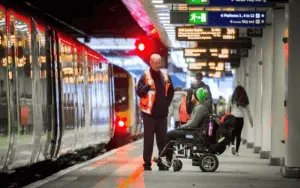Network Rail is being questioned again over its failure to provide funding to ensure the accessibility of new infrastructure, after it claimed it could not afford to ensure a new footbridge would be accessible to people with mobility impairments.
The bridge will link new housing developments on either side of a railway line in the Kennington area of Ashford, in Kent.
But the two developers say the funding they have provided in exchange for planning permission for their developments is only enough for a stepped bridge, and not the ramped version that previously secured planning permission.
The bridge, which will be built by Network Rail, will replace a level crossing that has been deemed unsafe because of the greater number of people now expected to use it.
Access campaigner Doug Paulley has told Kent County Council he will seek a judicial review if it does not meet its Equality Act duties and oppose Network Rail’s application to divert the public right of way from the level crossing to the new bridge.
He has told the council: “It is unacceptable that you appear unconcerned at the diversion of public paths over step-only footbridges for the sake of saving Network Rail and the developers money, thus baking in inaccessibility for decades to come.”
Paulley, himself a wheelchair-user, said he found Network Rail’s failure to provide the necessary funding to be “profoundly offensive”.
He previously played a significant role in persuading Network Rail to withdraw plans to build an inaccessible bridge at Copmanthorpe, near York, which again would have seen a dangerous level crossing replaced by a footbridge that could only be reached by steps, rather than ramps.
Network Rail this week provided several excuses for not providing the funding necessary to ensure the bridge was accessible.
It told Disability News Service (DNS) that the bridge was being funded by private developers and that Network Rail was “not funded” to “make up the shortfall”.
It claimed it only had funds for “renewals” of old bridges and not for “enhancements”, such as replacing a foot crossing with a bridge, which meant the Kennington request was “outside the railways funding envelope”.
It also said that “the funding envelope for the railway has been hit by the same inflation that has hit the developers”.
And it said that a Network Rail “diversity impact assessment” had found that a stepped footbridge was “the right option”.
Christiane Link, a consultant and adviser on accessibility, and also a wheelchair-user, wrote this week about the Kennington bridge plans and Network Rail’s “recent track record of building footbridges across the UK that exclude disabled people entirely” which she said was an “appalling contradiction of promises on accessibility and equity”.
She wrote: “Network Rail’s reliance on cost savings all the time, as well as the claim that future upgrades might someday provide lifts, simply bakes in inaccessibility for decades.
“It tells disabled people they’re an afterthought, only to be accommodated if funds miraculously appear or pressure mounts.”
She added: “Research consistently shows that truly accessible infrastructure delivers significant health, environmental, and mobility benefits, reducing congestion and boosting local economies for all.”
Asked by DNS why she thought an inaccessible footbridge should be built, independent councillor Linda Harman, Ashford Borough Council’s cabinet member for planning, housing delivery and communication, said the council was disappointed that the accessible bridge could not be built but that “a pragmatic solution had to be found for all parties” and that it was “vital that a safe crossing is put in place as soon as possible”.
One of the developers, Quinn Estates, has previously suggested that the inaccessible, stepped bridge was “groundbreaking” and would provide “a template for the railway network in other parts of the country where footbridges require replacement, or the safety of existing level crossings are a cause for concern”.
Network Rail, the developers Quinn Estates and Barratt Redrow, and Ashford Borough Council, had all failed by noon today (Thursday) to say how much extra the accessible version of the bridge would cost.
A spokesperson for Kent County Council (KCC) said: “We are aware of the issue over the planning permission for a stepped bridge which has been granted by Ashford Borough Council.
“As the local highway authority, KCC is now processing the associated diversion order application as required.
“At this stage, we have not taken a formal position on the matter and are due to determine this soon.”
Network Rail is developing a growing reputation for claiming it is too expensive to ensure that new rail infrastructure can be accessed by disabled people.
Just two months ago, its decision to spend nearly £8 million building a new – inaccessible – footbridge was labelled an “appalling contradiction” of the government’s commitment to improving the accessibility of the public transport system.
A year ago, it was forced to apologise after admitting it had failed to spend £65 million of funding allocated to improving access at rail stations.
And two years ago, it made the “profoundly offensive” admission that it planned to build 17 inaccessible footbridges across England, Scotland and Wales.
Picture: Christiane Link (left) and Doug Paulley
A note from the editor:
Please consider making a voluntary financial contribution to support the work of DNS and allow it to continue producing independent, carefully-researched news stories that focus on the lives and rights of disabled people and their user-led organisations.
Please do not contribute if you cannot afford to do so, and please note that DNS is not a charity. It is run and owned by disabled journalist John Pring and has been from its launch in April 2009.
Thank you for anything you can do to support the work of DNS…

 Bus company’s urgent probe after driver called for wheelchair-user who reported discrimination to be shot
Bus company’s urgent probe after driver called for wheelchair-user who reported discrimination to be shot Air travel accessibility report could lead to ‘tangible’ improvements, but progress depends on industry
Air travel accessibility report could lead to ‘tangible’ improvements, but progress depends on industry Regulator’s report on rail assistance ‘shows it is still failing to acknowledge right to turn up and go’
Regulator’s report on rail assistance ‘shows it is still failing to acknowledge right to turn up and go’